The Finnish Army of the 1920’s – Part II
This section on the Finnish Army of the 1920’s will, by way of background and as an aid to understanding the impact of the changes made in the 1930’s, take a brief look at the Finnish Army Training and Mobilization Plans of the 1920’s. Training will be split in two, with one (rather short) section covering Conscript Training, and the other covering Army Officer and NCO training. Looking ahead, we’ll also cover the background to the basic Army structure (Cadre vs Militia), Conscription (and the background to Conscription) and take a very quick and high level look at divisional organisation and size, infantry weapons and some of the other equipment that was available – all in the 1920’s.
Hope you find it interesting ….. and keep in mind that while this is an ATL, this particular section is OTL and firmly grounded, historically speaking, on what actually happened and/or was actually available. As far as the Armeijan (Army) and Ilmavoimat (Air Force) go (and Suojeluskunta for that matter) I won’t be playing fast and loose with the historical facts until we get past 1930. So, to move on with the story and give you a little more background…..
Suomen Armeijan (Finnish Army) Training in the 1920’s
Conscript Training
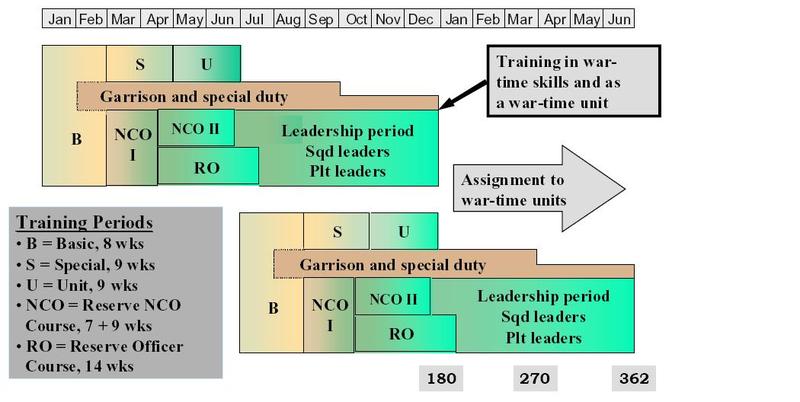
Finnish Army Conscript Training
The diagram below provides a basic outline of Conscript Training. Generally, conscripts were kept in the Army for a period of 12 months. All conscripts completed an 8 week Basic Training Program, following which soldiers completed 8 weeks of Specialist Training and then 8 weeks of Unit Training. While soldiers were completing Specialist training, those conscripts selected for NCO Training completed the first phase of NCO training. Towards the end of this phase, Reserve Officers were selected from those in NCO Training. Reserve Officer and NCO Phase 2 training was completed in parallel, after which NCO’s and Reserve Officers rejoined the Soldiers for six months of training in war-time skills operating as a war-time unit.
The Suomen Armeijan did not generally have regular force (as opposed to Conscript) privates (although the Border Guard did, as did the more technical branches of the forces) and the 30,000 man strength of the 1920’s Armeijan was made up primarily of Conscripts, Conscript NCO’s and Conscript Reserve Officers. Not having data available for the 1920’s, the best I can do is quote a table from 1939 on the Cadre Army’s strength. Kronlund gives a figure of 2,182 Regular Officers, 4,311 Regular NCO’s and 26,435 “Miehistö” (Conscripts). The vast majority of the last were, of course, Privates doing their 350-day long military service and conscripts being trained as Reserve NCOs and Reserve Officers (Roughly 75/20/5%, respectively). Once the Finnish system was well-established in the late 1920’s, everything was built upon the conscript service; that’s where the reserves were trained and that’s where the future NCOs and officers, career as well as reserve, were found.
After a period of basic training common for all, those chosen for a “leadership role” entered a period in a “NCO school” and after that those chosen entered a period in a “Reserve Officer School”. Meanwhile the privates and reserve NCO’s trained together and the reserve officers would finally join them to use their newly acquired wisdom in practise. There were slight variations, but since 1935 the lengths of the periods were 17, 17, 17 and 16 weeks. Last but not least, the reservists – privates, NCO’s and officers alike – often received valuable training either in their local Suojeluskunta or in “reserve training exercises”. For instance, between 1935 and 1939, more than 180 000 men took part in these, usually 1-2 week long, exercises (which were more common in the later 1930’s, not common at all in the 1920’s).
Regular NCOs — known as kapitulanttialiupseerit — graduated from a school of their own. Regular Officers were either reservists who enlisted for a fixed period at some point after the end of their conscription period or graduates of the three-year military academy Kadettikoulu founded in 1919. Of course, only the latter graduates had any career prospects within the Armeijan, and often the ‘regular reservists’ were just biding their time to apply for the Kadettikoulu. Those wishing to become career officers or NCOs would usually first continue their service as temporary (i.e. reserve, with pay) Officers or NCOs for a duration, typically a summer or up to a year until they could apply for entrance to the three-year “Kadettikoulu” or in the six-month schools for NCOs.
In other words you couldn’t become a career officer without successfully finishing your military service and you couldn’t enter the “Kadettikoulu” if you had failed to make it into the “reserve officer school” during your conscript service. There were educational requirements for officers, i.e. in principle you had to have done the equivalent of your A-levels/baccalauréat/Abitur, but it sufficed with less. The career path of a regular NCO was simply a very slow climb in the NCO ranks; exceptions were not made until after the Winter War. Both officers and NCO’s served until retirement after 20(?) years of service, i.e. there were no short-service Cadre Officers or NCO’s.
The system did not work as well as it could, though due to economic restraints. In the 1920’s, much of the conscripts time, up to a third or even a half, was spent in unessential work or guard duties and there were not enough Officers and NCO’s to meet the actual training needs. The quality of career Officer and NCO applicants was often less than desired (due to the rather poor pay, drab living conditions etc).
Officer Training in the Early Years (1917-1920)
After the abolition of the “Finnish” Army in 1905, military training had not been available in Finland and those desiring to enter the military had either to enter the Tsarist Russian Army or turn to the military of other European countries. With growing opposition to Russian rule and a growing desire for independence, when WW1 broke out the eyes of many Finns had turned to Germany, which gave rise to the Jaeger movement. In the autumn of 1917, some 60 Finnish Jaegers arrived from Germany and began to organize military training of Suojeluskunta units. There were not enough trained Jaegers available to provide officers for all the Suojeluskunta units and the need was seen to quickly organize and train Suojeluskunta Officers and Platoon Leaders.
The first independent Finnish officer training course was held in the small rural town of Vimpelin, with the course lasting from 28 December 1917 to 13 January 1918. On 12 January 1918 it was decided, based on the experience of the Vimpelin training course, to organize an even larger military training course in the Ostrobothnian town of Vöyri., which would provide 700 Suojeluskunta members with NCO and Ryhmä (Section or Squad)-leader training. The first students arrived on 26 January, only a couple of days before the Civil War began. Over February-March 1918 the numbers of students increased as and when trainees were assigned from units at the front. The course was headed by Jaeger Captain Juho Henrik Heiskanen.
Vöyrin Marssi (The Vöyri March)
Suojeluskunnat Suomenmaassa / The White Guards in Finland
järjestystä vaatii, / call for order,
kaikki ryssät maasta pois / all Russians out of the country
ja alas punakaarti. / and down with the Red Guards.
Hei! Saksanniemi, Jääkärijoukko, / Hey! Saksanniemi, Jäger unit,
Lapuan ja Härmän joukko, / troops of Lapua and Härmä,
Vöyri, Kauhava ja muut… / Vöyri, Kauhava and other places…
Jääkäreillä mukanaan / Along with the Jägers
on menestys ja onni, / comes success and luck,
meikäläisten vyöllä riippuu / on our belts hang
saksalainen pommi. / German grenades.
Hei! Saksanniemi, Jääkärijoukko, / Hey! Saksanniemi, Jäger unit,
Lapuan ja Härmän joukko, / troops of Lapua and Härmä,
Vöyri, Kauhava ja muut… / Vöyri, Kauhava and other places…
Pikkuryssät Pietarissa / Little Russians in St. Petersburg
näkee pahaa unta, / see bad dreams,
Venäjä on rajamaa / Russia is a borderland
ja Suomi valtakunta. / and Finland an independent state.
Hei! Saksanniemi, Jääkärijoukko, / Hey! Saksanniemi, Jäger unit,
Lapuan ja Härmän joukko, / troops of Lapua and Härmä,
Vöyri, Kauhava ja muut… / Vöyri, Kauhava and other places…
Eespäin veikot, pelko pois / Forward brothers, fear away,
ja rivakasti tahti, / and a swift pace,
suojeluskunnat Suomenmaan / the White Guards of Finland
on vapauden vahti. / are the guards of freedom.
Hei! Saksanniemi, Jääkärijoukko, / Hey! Saksanniemi, Jäger unit,
Lapuan ja Härmän joukko, / troops of Lapua and Härmä,
Vöyri, Kauhava ja muut… / Vöyri, Kauhava and other places…
Kenraalimajuri Juho Henrik HEISKANEN (18 Dec 1889 – 11 Dec 1950)
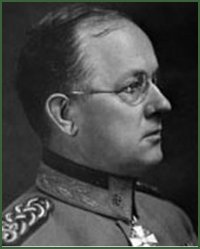
Major-General Juho Henrik Heiskanen (1889 – 1950)
- 15 Oct 1918 – April 1919: Commander, Sotavalsky Border Guard Battalion
- April 1919 – Dec 1920: Commander, North Savo Regiment
- 29 Dec 1920 – 19 April 1921: Commander, II Bicycle Battalion
- 20 April 1921 – 11 February 1024: Commander, I Bicycle Battalion
- 12 Feb 1924 – 15 Jun 1928: Commander, Tampere Regiment
- 21 Aug 1927 – 27 Aug 1928: Acting Commander, 3. Division
- 6 Dec 1927: Promoted to Eversti
- 15 Jun 1928 – 1 Jan 1934: Commander, Jäger Brigade
- 1 Jan 1934 – 31 Aug 1934: Commander, 2. Division
- 31 Aug 1934 – 8 Oct 1939: Commander, 3. Division
- 6 Dec 1934: Promoted to Kenraalimajuri
- 8 Oct 1939 – 3 Dec 1939: Commander, IV. Army Corps
- 3 Dec 1939 – 1 Mar 1941: Chief of Fortifications, Deputy Inspector-General’s Office
- 1 Mar 1941 – 30 Aug 1941: Inactive
- 30 Aug 1941 – 16 Oct 1941: Commandant of Viipuri
- 16 Oct 1941 – 30 Dec 1944: Special Purposes Officer, Inspectorate-General of Military Training
- 30 Dec 1944: Transferred to the Reserve
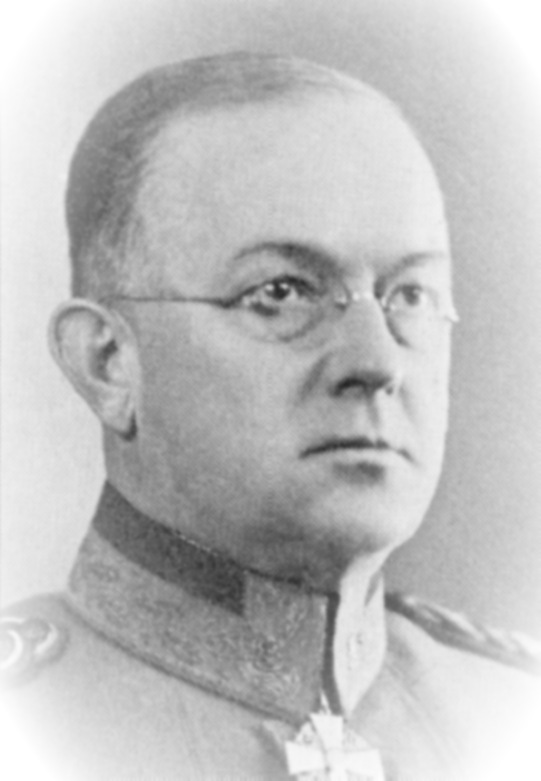
Jaeger Major-General Juho Henrik Heiskanen
Juho Henrik Heiskanen (in Germany as a Jaeger he used the alias Heissman, 18 December 1889 Pielisensuu – December 11, 1950 ) ended his career in the Finnish Army as a Major General . His parents were small farmers Paavo Heiskanen and Katri Väänänen. He was married in 1918 to Kyllikki Hissan. Heiskanen graduated from high school in Joensuu classical lyceum in 1911 and joined the Karjalainen Students’ Association. He continued his studies at the University Law Faculty in 1911-1914 and conducted initial examinations for a legal degree in 1912. He was Sääminki district acting police chief when he joined the ranks of the Finnish Jaegers as one of the first volunteers, who traveled to Germany for military training at the Pfadfinder course , which took place in the North German Lockstedter Lager training area. He reported to camp 2 March 1915. He was placed in command of 2 Company. Later, he was assigned to the Engineer Company of the (Finnish) Prussian Jaeger Battalion 27 (31 August 1915). He took part in the fighting against the Russians on the Eastern Front on the Misse River, after which he was sent on explosives courses in Berlin and Kiel and then in August 1916, he was ordered to special duties in Finland.
In Finland, Heiskanen was unfortunately 2 October 1916 , arrested in Jyväskylä on 2 October 1916 by the gendarmes, transported to Helsinki, then in October 1916 sent to prison in St. Petersburg. He was released from prison at the beginning of the Russian Revolution on 12 March 1917 and returned to the Jaeger battalion. Heiskanen left Danzig on the SS Equity with the only major arms shipment to the White Army in Finland that made it through before the Civil War began on Ostrobothnia. He participated in distributing arms to the Southern Ostrobothnia Suojeluskuntas (Civil Guard) and was then assigned to command the Southern Ostrobothnia Suojeluskuntas units, then the Vaasa Guard.
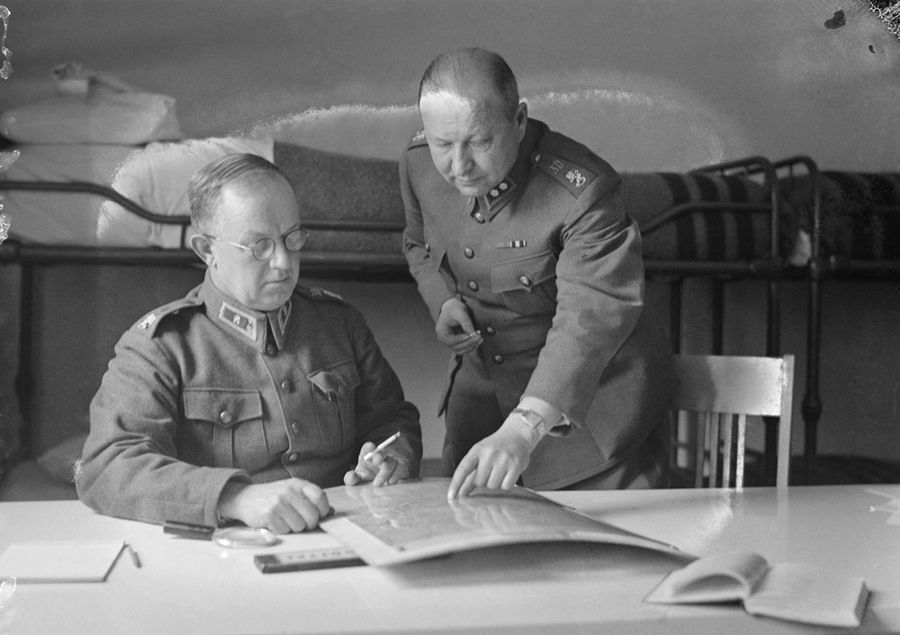
Major General Juho Heiskanen and his chief of staff Lieutnant Colonel Harry Kinnunen study maps – 1937
Under Heiskanen’s command, the Southern Ostrobothnia Suojeluskuntas units had, at the beginning of 1918, 2,500-3000 light infantry. This crack operational unit gave Mannerheim an decided advantage in the Spring of 1918, with Heiskanen taking part in the disarmament of Russian units in Lapua and Seinäjoki. Through early February, Heiskanen commanded at the frontlines but on 18 February 1918 he was posted as commander of the Vöyri War School, based in the small rural town of Vimpelin. He was soon appointed to command the Vöyri Battalion at the Tampere front. After Tampere was captured he was assigned to command the North Savo Regiment, where he led the capture of Viipuri and Hamina.
After the Civil War, Heiskanen continued in command of the North Savo Regiment, later being posted to command of the crack Helsinki Guards Regiment, the Sortavalsky Border Guard Battalion, I and II Bicycle Battalions respectively, then the Tampere Regiment, the Jaeger Brigade, 2 Division and then 3 Division. He was briefly Commander, IV. Army Corps at the start of the Winter War, following which he was appointed Inspector General of Fortifications and then Inspector General of Military Training. Heskainen transferred to the Reserve in December 1944. It was a not untypical career for a career Officer in the Finnish Army.
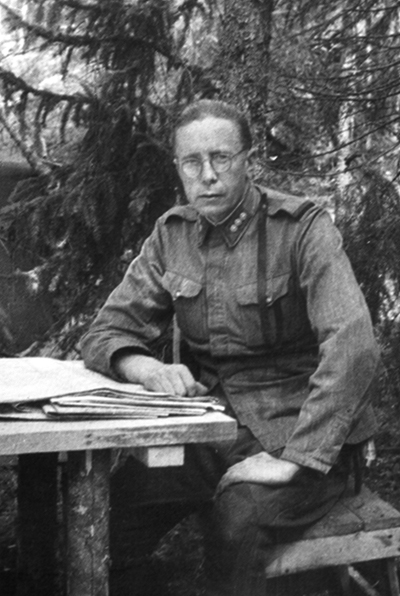
Colonel Jaakko Sakari Simelius in 1944. Simelius later became General of Infantry and the Finnish Chief of Defence.
After the war, a variety of officers courses were conducted, the most famous are probably the officer cadet courses held in “Markovilla-village” in Viipuri. This was the program which became the backbone for future reserve officer training. The first course started on 1 April 1920 with 143 students and was run by Jaeger Captain Kosti Sundberg. The participants of this course were proud of it, and called themselves “Markovilla Officers”. The best known of them was the late General of the Infantry Sakari Simelius (who went on to become CIC of the FDF between 1959 – 1965.
(Simelius attended the officer cadet course in 1919, the Military Academy in 1924 and the University of Minnesota in 1939. He began his career as a junior officer in the Uusimaa Regiment of Uusimaa and was a company commander from 1919 to 1928. He taught at the Military School from 1928 to 1933. From 1933 to 1938 he was posted to the Vyborg Civil Guard and was also a military instructor at the Civil Guard officers’ school in 1938. In the Winter War he was a Lieutenant Colonel and chief of staff for 4 Division from 1939 to 1940. From 1941 to 1943 he served as Chief of Staff for VII Army Corps and from March 1943, commanded JR4 (4th Infantry Regiment). From later in 1944 until the end of 1946, Simelius commanded JR7. From 1946 to 1952 he was Assistant Director of the War College and from 1952 to 1953 he was the Director. In 1953 he was promoted to Major-General and commanded 3 Division through to 1955. He then served as Inspector of Infantry from 1955 to 1959 and was Chief of Defence from 29 October 1959 to 13 November 1965, after which he retired from the Armed Forces).
War College Courses abroad
Following Independence and after the war, there was a shortage of trained General Staff Officers, which would continue until Finland had set up its own military academy to train General Staff Officers. In the early years, the General Staff was largely made up of ex-Tsarist Russian Army officers and Officers trained by the Germans (the “Jägers”), many of whom had had no General Staff training) and Officers trained abroad through the 1920’s by the victorious powers, mainly in France and Italy.
The Chief of General Staff, Oscar Enckell, set strict conditions for foreign study in the early years, which resulted in problems for officers in training. Language skills were also a problem, as very few Finnish Officers could speak French or Italian. In addition, the diversity among the Finnish Officer Corps caused problems, as among them there were several groups of personnel with entirely different backgrounds and levels of training: those trained in Russia, Jäger officers trained in Germany, and those who had risen in the ranks from civilian to active officers during the Finnish Civil War.
The higher-ranking Jäger officers in particular felt that the former Russian Army officers who held many of the most senior positions in the Suomen Armeija discriminated against them when opportunities for training were available. There were preconditions set for studying abroad: holding Rank of at most, a Captain, being Single and having sufficient school education. For the young and married Majors and Lieutenant Colonels with a Jäger background, these conditions were impossible to fulfill. There was also a political question: in which country the General Staff training was to be arranged, as the Jäger officers were politically more oriented towards Germany than towards the Entente states. A General Staff course in Germany was a politically touchy issue, as in the Versaille peace treaty Germany was forbidden to give such education, and in addition Finland had officially severed its relations with Germany as the German Empire had collapsed. The Jägers however still sympathized with the defeated Germany that had helped them in the hour of Finland’s need.
The young Kinship Activist, Major Paavo Sivén, had organized two privately funded General Staff courses for Finnish Jäger officers in Germany in 1921-1923 and 1923-1925. The Chief of the Military Academy, Jäger Major-General Aarne Sihvo, in 1926 approved the General Staff Officer Diplomas from the first course in Berlin as corresponding with the two-year curriculum of the General Department of the Staff College, but the Diplomas of the latter course were not approved. A court case regarding the validity of the second Berlin Course Diploma went all the way to the Supreme Court, with the Diplomas finally being confirmed in early 1930. Altogether, 13 Finnish officers had carried out General Staff studies in Berlin, Germany. After the “officer crisis” was resolved, Finland sent a number of higher-ranking Jäger officer to foreign Military Academies. A total of 46 Finnish military officers, including the future Defence Force Commanders Erich Heinrichs and Aarne Sihvo, studied in French and Italian military academies.
Kadettikoulu / Officer Training School (1919…)
There were many Officers without formal training and there was a real need for an Officers Training School. A Committee headed by Major General Hannes Ignatius was set up on 4 January 1919 to come up with recommendations for Officer Training. The Committee worked quickly and the new Finnish Officer Training School began operations on 25 January 1919. The new Academy was located in Helsinki and the initial length of the Officers Training was set as eighteen months. From 1930 (through to 1962 when it was further lengthened), the course took two years to complete. Specialized training was conducted in military schools organized and run by the Specialist Branches. Navy Officer-candidates were educated at the School until 1930, and Air Force Officer-candidates until 1929.
In 1930, the requirement to enter the Kadettikoulu (Officer Training School) was that the applicant had to be less than 25-years-old, have passed the Matriculation Examination, have a good reputation, be physically fit and in a good state of health as well as fit for the particular branch of the defense forces being applied for, and suitable for promotion as a reserve officer, but those requirements were interpreted loosely. From 1919 to 1923 the Kadettikoulu was located in what is now the Museum of Natural History. The building had previously served as a Russian Gymnasium. From 1923 to 1940 the Military Academy was located in Helsinki Munkkiniemi and then in Santahamina from 1940. The first Director of the Military Academy was Colonel Victor Rafael Schauman. The first three directors were all former students of the Finnish Cadet School [of the Imperial Russian Army, (acting 1821–1903)]. Jaeger Officers acted as teachers at the Kadettikoulu until 1945. The first three directors of the Finnish General Staff College were all former students of the Kadettikoulu.
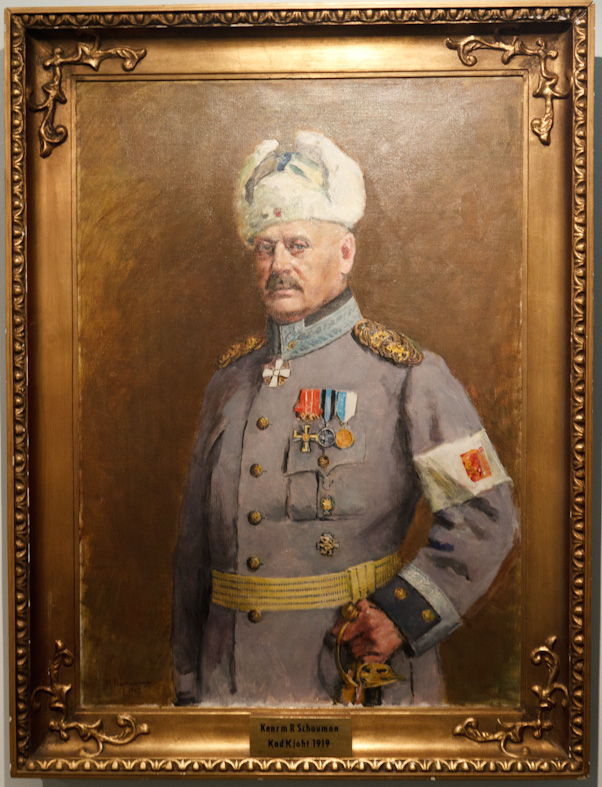
Major General Victor Rafael Schauman, Kadettikoulu Director 1919
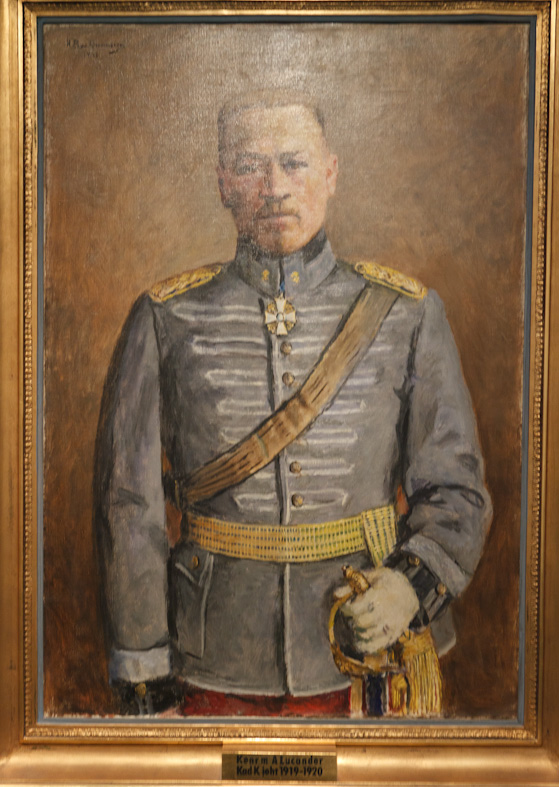
Major General A Lucander, Kadettikoulu Director 1919-20
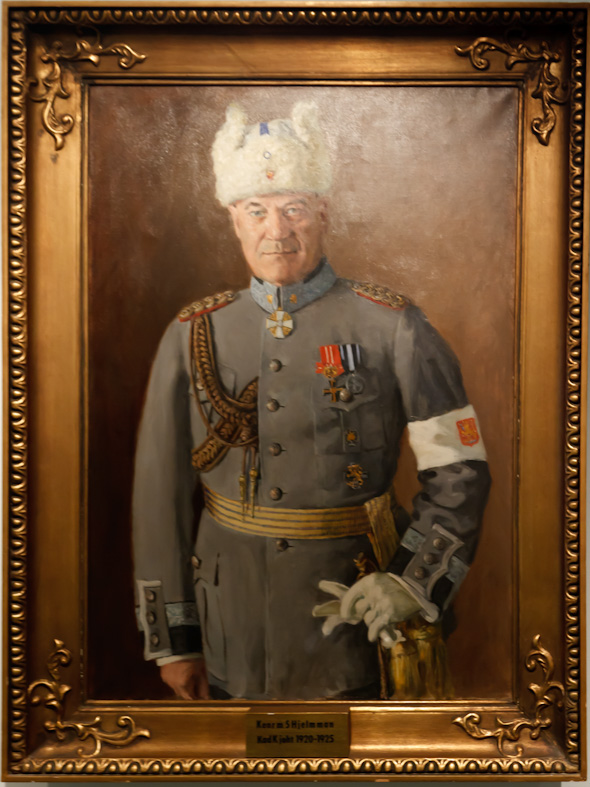
Major General S Hjelmman, Kadettikoulu Director 1920-25
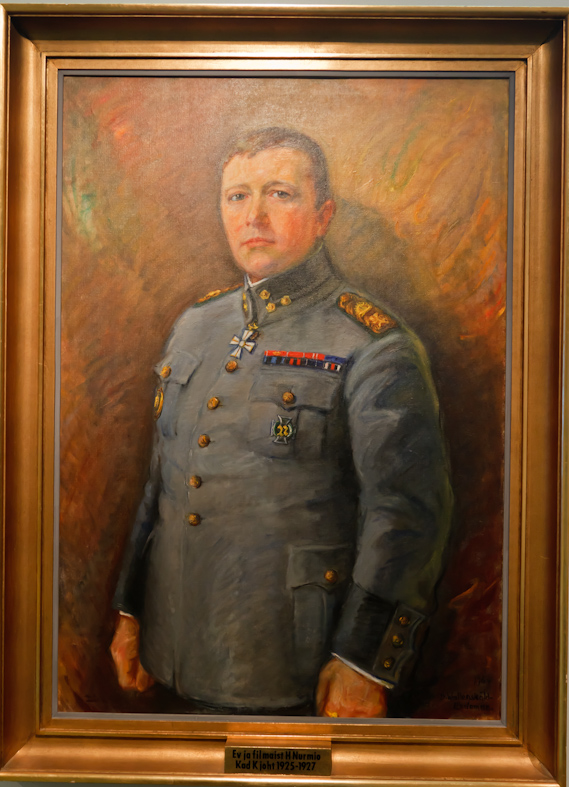
Colonel and Magister of Philosophy H Nurmio, Kadettikoulu Director 1925-27
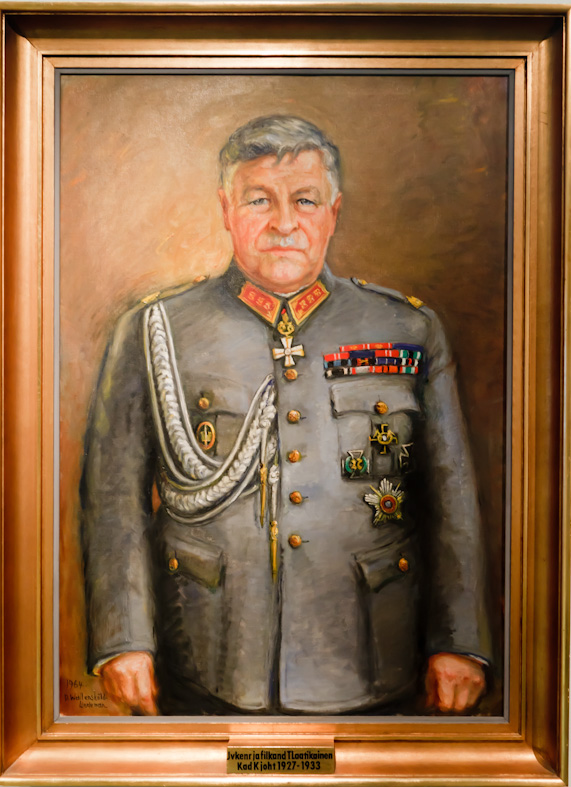
Infantry General and Candidate of Philosophy T Laatikainen, Kadettikoulu Director 1927-33
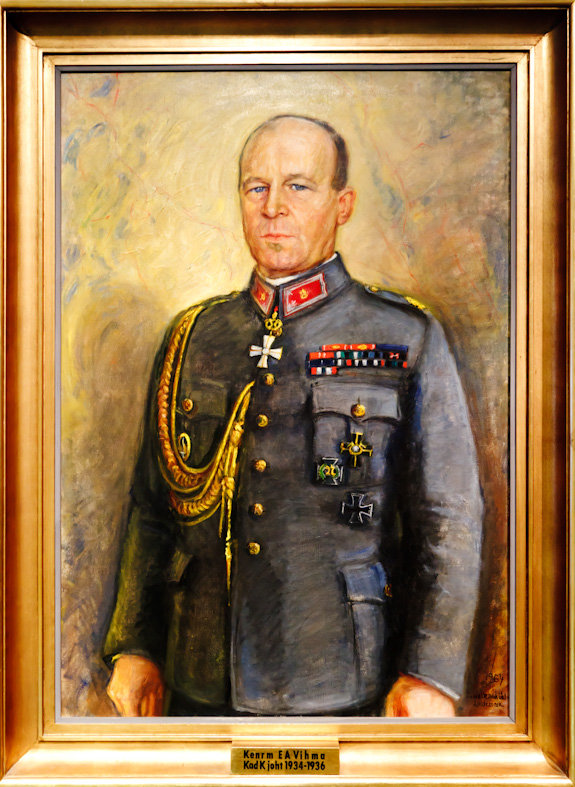
Major General E A Vihma, Kadettikoulu Director 1934-36
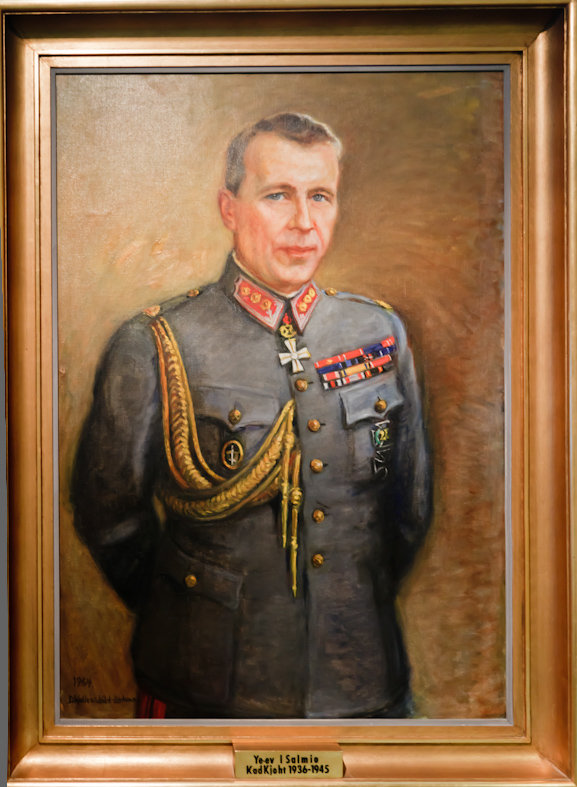
General Staff Colonel I Salmio, Kadettikoulu Director 1936-45
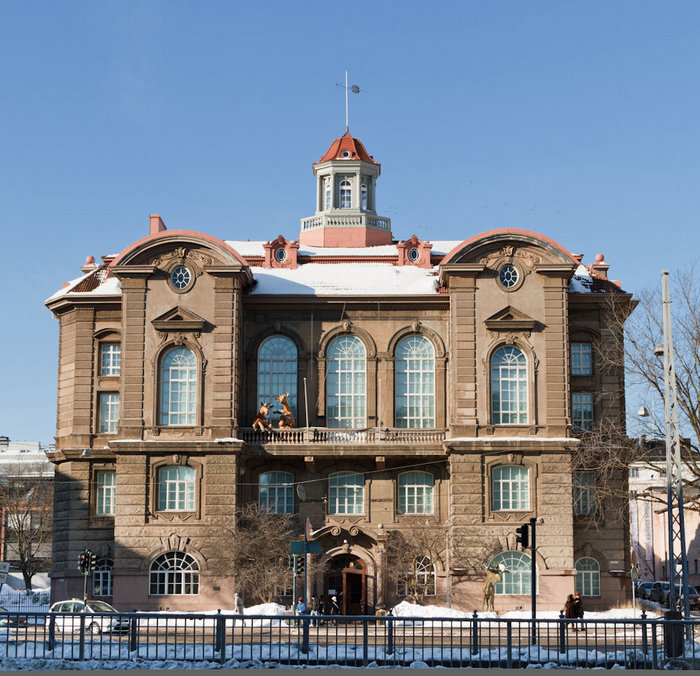
This building in Helsinki was the first site of the Kadettikoulu of the independent Finland in 1919-23
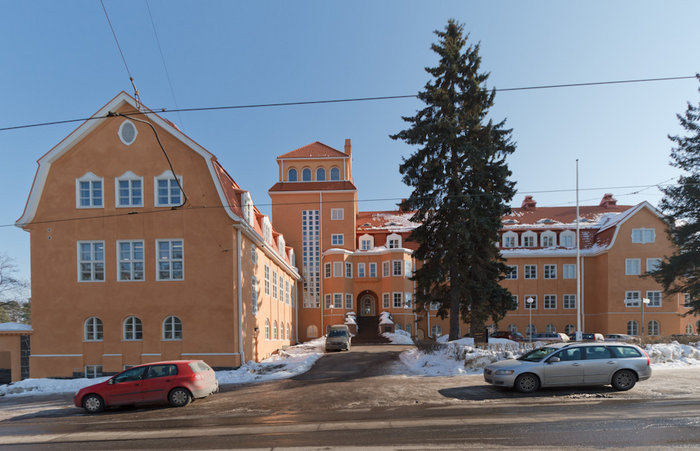
This building in the suburb of Munkkiniemi in Helsinki, originally a pensionate, was the second site of the Kadettikoulu of the independent Finland in 1923-40, before it finally moved to the garrison island of Santahamina
By the year 1939 the Kadettikoulu had been training junior Officers for 20 years and there were plenty of them. However, the highest positions in the defense forces were firmly in the hands of the Jägers, the graduates of “Viipurin Upseerioppilaskurssi” of 1919 and some who had served in the old Imperial Russian army (prominent among these were Mannerheim and Nenonen). The only Officer who had graduated from the Kadettikoulu after 1919 to command a division (10.D) in WW2 was Colonel Kai Savonjousi. Savonjousi was also the first Kadettikoulu officer to reach Major-General’s rank (in 1949) although before him another Kadettikoulu officer, Svante Sundström, had been promoted to Kontra-Amiraali (rear-admiral) in 1943. ATL, this would change in the mid-1930’s as the Armed Forces were reorganised into smaller and much more heavily armed combined arms regiments.
An interesting external view of the conflicts within the Finnish Officer Corps at the time as well as on foreign training for Finnish Officers can be found in a report from the Latvian envoy in Helsinki, K. Zarin: “The Finns are not doing well at all in organising their army. Right from 1918 onwards there is no agreement among their officers. The jääkäri (friends of the Germans) hate those officers who have served n the Russian army. The latter, of course, reply with the same. It is said that in officers clubs of several regiments the jääkäri and their colleagues (the former Russian officers) don’t even sit at the same table. It would not be so bad, were it only a case of disagreement among the officers; but I am told that officers often show this hatred and contempt among soldiers, too. As is known, former Russian officers cannot go on the attack, since they know that they have nothing to be proud of in front of masses. Thus they are slightly more acquiescent and at most pursue a defensive policy. In view of this there has long been talk of reorganising the Finnish army, or more precisely the army leadership.”
Politics were also drawn into the officers unrest, i.e. fascism. The envoy described the opposition by the ultrapatriotic jääkäri to the army commanders serving up to now, the former Russian officers, as a “strike”, which was followed by a reorganisation of the army with significant staff changes. However, the question inevitably arose of how to ensure change and reorganisation, since apart from the former Tsarist Russian officers, the Finns had virtually no other specialists. The jääkäri were still young and lacking in necessary education and experience, and Finnish military and political circles discussed the possibility of an orientation towards one of the great military powers and towards invitation of foreign experts. In the view of K. Zarin¸ the jääkäri would probably prefer these to come from Germany. Since France was unacceptable to the Finns for political reasons, and Italy and Belgium were not rated highly from the military point of view, only Britain remained.”
Maavoimat Taistelukoulu / Army Combat School (1927 on…)
The Army Combat School was set up in 1927 at a location north-east of Vyborg to conduct military leadership, battle training and combined arms combat courses for company commanders and platoon leaders. The school’s courses were based on the tactics taught at the Staff College, and were taught by Jaeger Maj. Hannes Olkkonen, who was also the school’s first director. Students were generally Captains and Lieutenants, as well as NCO’s who acted or might have to act as Company Commanders and Platoon Leaders. All Infantry Officers attended this course.
Sotakorkeakoulu / General Staff College (1923…..)
In 1919, direction was given to establish the Sotakorkeakoulu (General Staff College) in order to provide General Staff training for higher ranking Officers. In those uncertain times, the institute was not founded immediately but instead, several officers, including Jäger Major A. E. Martola, were sent to study at foreign Staff Colleges. The project of establishing the Staff College resurfaced in 1923. A Committee was set up to consider advanced officers’ training. The report of the Committee of May 1923 proposed the establishment of a Sotakorkeakoulu, one of the reasons (among others) being the need to develop original tactics applicable to Finnish circumstances and terrain. At the same time, Colonel V. P. Nenonen, the Inspector of Artillery, had taken the initiative to organize a higher military-technical educational program at the Institute of Technology. This initiative had progressed rapidly and in the autumn of 1923, some 18 Officers began studies at the Institute of Technology in Helsinki.

Former Military Academy in Kruununhaka, Helsinki, Finland
The actual establishment of the Sotakorkeakoulu gained new momentum when in April 1924 the Defense Revisions Committee presented a strong statement in support of higher military education. The petition resulted in the Government agreeing almost immediately to the motion for the establishment of a temporary Sotakorkeakoulu. The Sotakorkeakoulu began teaching in Helsinki on 11 March 1924 in the former barracks of Uusimaa Marksmen Battalion at Liisankatu. The General Staff College’s first Director was Colonel Aarne Sihvo, who at the time was actually studying at the Italian Military Academy. Major General Nenonen was initially nominated as the interim Director, with General Staff Major Martola as his Assistant. The school’s tenured teachers were all foreign: from Sweden, Italy, France and Great Britain. 34 officers were assigned to the first course. In addition, those students who had started their studies at the Institute of Technology continued their education at the Sotakorkeakoulu from the autumn of 1925.
The selection criteria for the Sotakorkeakoulu was stringent and students had to work extremely hard. Accordingly, the graduates were considered the intellectual elite of the Defense Forces. At some point after graduation the successful students were granted the status of Yleisesikuntaupseeri (General Staff Officer) and were allowed to add the prefix Yleisesikunta- before their rank, for example Yleisesikuntaeversti for a Colonel (or just Ye-eversti for short). OTL, before World War II the Sotakorkeakoulu had trained 370 General Staff Officers in 15 General Department courses, five Military Technical Department course, two Naval Department courses and one Air Warfare Department course. (46 officers also carried out corresponding studies abroad, mainly in Sweden, Germany, France and Italy). Courses were generally of two years’ duration, but the Military Technical Department Courses lasted four years. The Sotakorkeakoulu was made a permanent institution in 1930.
Suomen Maavoimat Military Schools through the 1920’s
Sotakorkeakoulu (SKK) (General Staff College) Helsinki
Taistelukoulu (TK) (Combat School) Viipuri
Kadettikoulu (Kad.K) (Officer Cadet School) Munkkiniemi (Helsinki)
Sotateknillinenkoulu (STK) (Military Technical School) Helsinki
Merisotakoulu (MSK) (Naval Combat School) Suomenlinna (Helsinki)
Ilmailukoulu (Ilm.K) (Aviation School) Kauhava
Reserviupseerikoulu (RUK) (Reserve Officer School) Hamina
Aseseppäkoulu (ASK) (Gunsmith School) Helsinki
Kengityskoulu (Keng.K) (Shoeing School) Hämeenlinna
Sotilashallinnollinenkoulu (SHK) (Military Administrative School) Helsinki
Kaasusuojelukoulu (Kss.K) (Gas Protection School) Viipuri
Part of the education was also arranged within the specialized branches of the defence forces, e.g. Combat Engineer, Signals, Artillery, Quartermaster, etc. who had also developed internally their own specialised training courses in addition to their responsibilities for conscript training. There was a shortage of everything as funding was scarce and all sorts of improvisations and innovations were used to compensate for the lack of resources. But the new Officer Corps was highly motivated and had a pioneering spirit, hence the system was not rigid but rather was adaptive. For example, the famous motti tactic of the Winter War was not invented by theorists or taught at the pre-war Staff College, it was created in combat by innovative thinking and boldly utilizing opportunities that arose (an approach which had still benefited from sound professional officer training and correct appraisals of the situation and the opportunities).
A perhaps-typical example would be General Jarl Lundqvist, who completed the following courses:
Field Artillery School (Tykistön Ampumakoulu) in 1920
Course at “Ecole Militaire de l’Artillerie de Fontainebleau” between 1 October 1920 and 20 August 1921,
General Staff Course in gas protection (Ylemmän Päällystön Kaasukurssit) in 1927,
Course at “Centre d’Etudes Tactiques d’Artillerie” in Metz between 1 June – 9 July 1928,
Course “Ecole Superieure de Guerre” in Paris between 1 November 1928 – 6 June 1930 and Observer Training in France in 1934
Lundqvist was promoted from Captain to Major in 1920, to Lieutenant Colonel in 1925, to Colonel in 1928, to Major General in 1936.
Here for example are two tables showing the numbers of Finnish Officers attending foreign training courses over the period 1919-1939 (from Suomen Puolustuslaitos 1918-1939 by Jarl Kronlund).
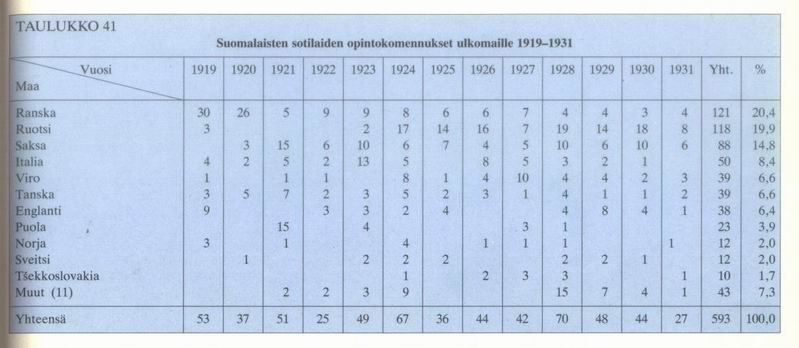
Table of Finnish Officers attending foreign training
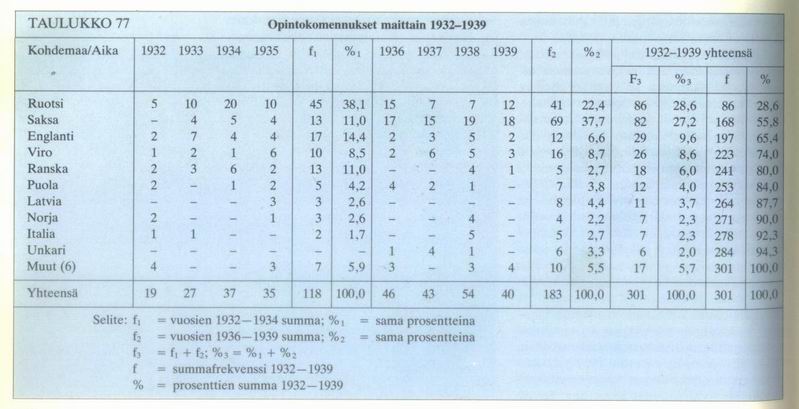
Table of Finnish Officers attending foreign training
Overall, we can see that the Finnish Army of the 1920’s made substantial progress in establishing a sound training structure for both junior Conscript and for Career Officers. Small numbers of offices were sent abroad for foreign training and the War College in Finland training numbers of General Staff Officers. On the other hand, the internal conflict between the “Jaegers” and the “Russians” still existed and equipment-wise, the Army was poorly equipped. All this would change through the decade of the 1930’s, as we will see.
Return to Table of Contents for “Punainen myrsky – valkoinen kuolema” (Red Storm, White Death)
 Copyright secured by Digiprove © 2013 Alternative Finland
Copyright secured by Digiprove © 2013 Alternative Finland


Pingback: 6 Scary Places to Visit in Helsinki
Pingback: Luonnontieteellinen museo (The Natural History Museum of Helsinki) – ilovemuseums